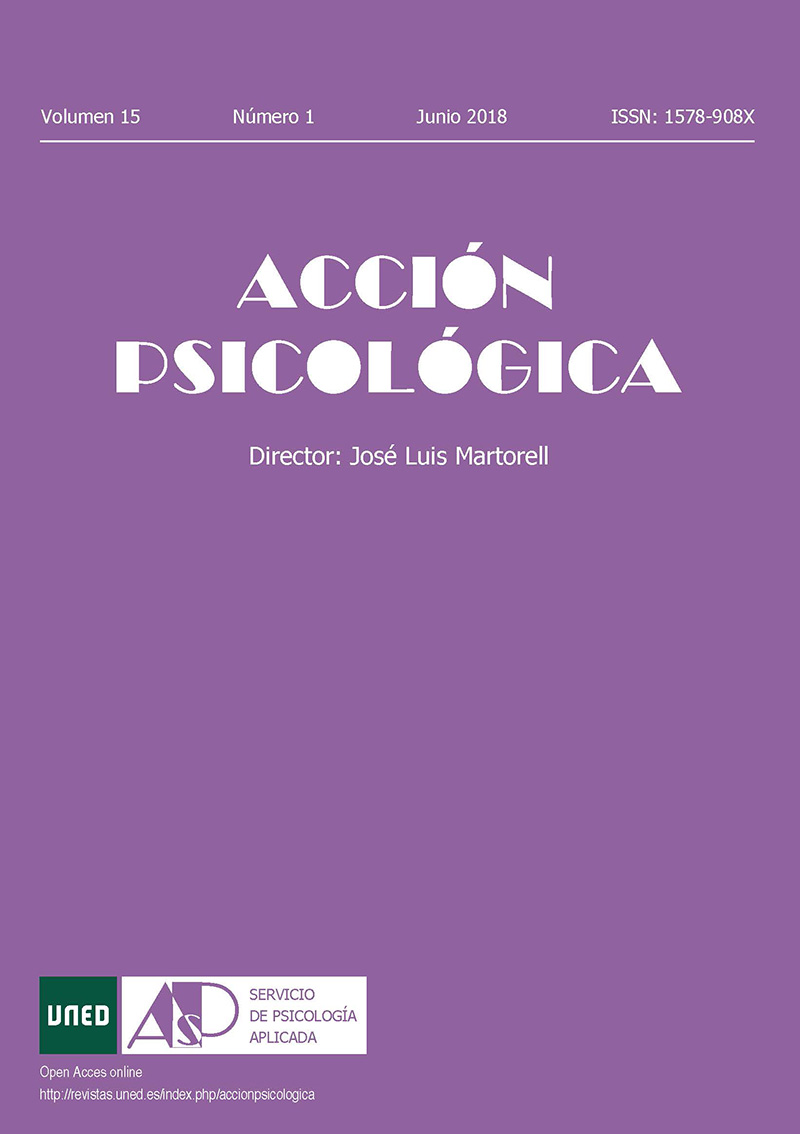Spanish versión of the Short Depression-Happiness Scale (SDHS): A Reliability and Validity study in a simple of Spanish Elderly People
DOI:
https://doi.org/10.5944/ap.15.1.21196Keywords:
happiness, depression, psychometric properties, elder peopleAbstract
The psychometric properties of the Short Depression-Happiness Scale (SDHS) were analyzed in a sample of 216 Spanish elderly people with an average age of 73.89 (SD = 6.49). An exploratory factor analysis and confirmatory factor analysis were developed in order to identify the factorial solution and the best model fit. Just on factor was identified. Regarding reliability and validity, internal consistency index was .757 and the correlation between the Short Depression-Happiness Scale (SDHS) and measures of others construct, General Health Questionnaire (GHQ) and Center for Epidemiological Studies Depression Scale (CESD) (CESD), were significance. The practical implications of the scale and the index values obtained are discussed.
Downloads
References
Argyle, M. (1987). The psychology of Happiness. London, UK: Methuen & Co. Ltd.
Argyle, M., Martin, M., & Crossland, J. (1989). Happiness as a Function of Personality and Social Encounters. Recent advances in Social Psychology: An International Perspective (pp. 189-203). Oxford: Elsevier.
Bentler, P. M. (1990). Comparative Fit Indices in Structural Models. Psychological Bulletin, 107, 238-246. https://doi.org/10.1037/0033-2909.107.2.238
Bollen, K. A. (1989). A new Incremental Fit Index for General Structural Equations Models. Sociological Methods and Research, 17, 303-316. https://doi.org/10.1177/0049124189017003004
Crumbaugh, J. C. (1968). Cross-validation of Purpose in Life test based on Frankl’s Concepts. Journal of Individual Psychology, 24, 74-81
Crumbaugh, J. C. & Maholick, L.T. (1969). Manual of Instructions for the Purpose in Life Test. Abilene, TX: Viktor Frankl Institute of Logotherapy.
Diener, E. (1984). Subjective Well-Being. Psychological Bulletin, 95, 542-575. https://doi.org/10.1037/0033-2909.95.3.542
Diener, E., Emmons, R. Larsen, R., & Griffin, S. (1985). The Satisfaction with Life Scale. Journal of Personality Assessment, 49(1), 71-75. https://doi.org/10.1207/s15327752jpa4901_13
Goldberg, D. P., Gater, R., Sartorius, N., Ustun, T. B., Piccinelli, M., Gureje, O., & Rutter, C. (1997). The Validity of two Versions of the GHQ in the WHO study of Mental Illness in General Health Care. Psychological Medicine, 27, 191-197.
Harkness, J. A. & Schoua-Glusberg, A. (1998). Questionnaires in Translation. Zuma-Nachrichten Spezial, 1, 87-126.
Harman, H. H. (1976). Modern Factor Analysis (3rd Ed.). Chicago: University of Chicago Press.
Horn, J. L. (1965). A Rationale and Test for the Number of Factors in Factor Analysis. Psychometrika, 30, 179-185.
Hu, L. & Bentler, P. M. (1999). Cutoff Criteria for fit Indexes in Covariance Structure Analysis: Conventional Criteria versus new Alternatives. Structural Equation Modeling, 6, 1-55. https://doi.org/10.1080/10705519909540118
Jöreskog, K. G. & Sörbom, D. (1979). Advanced in Factor Analysis and Structural Equation Models. Cambridge: M.A. Abl.
Joseph, S., Lewis, C. A., & Olsen, C. (1996). Convergent Validity of the Depression-Happiness Scale with Measures of Depression. Journal of Clinical Psychology, 52, 551-554. https://doi.org/10.1002/(SICI)1097-4679(199609)52:5<551::AID-JCLP9>3.0.CO;2-Q
Joseph, S. & Lewis, C. A. (1998). The Depression-Happiness Scale: Reliability and Validity of a Bipolar Self-Report Scale. Journal of Clinical Psychology, 54, 537-544.
Joseph, S., Linley, P. A., Harwood, J., Lewis, C. A., & McCollam, P. (2004). Rapid Assessment of Well-being: The Short Depression-Happiness Scale (SDHS). Psychology and Psychotherapy: Theory, Research and Practice, 77, 463-478. https://doi.org/10.1348/1476083042555406
Kaiser, H. F. (1974). An Index of Factorial Simplicity. Psychometrika, 35, 401-415.
Lee, A., Steen, T. A., & Seligman, M. (2005). Positive Psychology in clinical Practice. Annual Review of Clinical Psychology, 1, 629-51. https://doi.org/10.1146/annurev.clinpsy.1.102803.144154
Lyubomirsky, S. (2007). The How of Happiness: A Scientific Approach to Getting the Life you Want. New York, NY: Penguin Press.
Lyubomirsky, S. & Lepper, H. (1999). A Measure of Subjective Happiness: Preliminary Reliability and Construct Validation. Social Indicators Research, 46, 137-155.
McGreal, R. & Joseph, S. (1993). The Depression-Happiness Scale. Psychological Report, 73, 1279-1282. https://doi.org/10.2466/pr0.1993.73.3f.1279
Peterson, C., Park, N., & Seligman, M. E. P. (2005). Orientations to Happiness and Life Satisfaction: The Full Life versus the Empty Life. Journal of Happiness Studies, 6, 25-41. https://doi.org/10.1007/s10902-004-1278-z
R Development Core Team (2008). R: A Language and Environment for Statistical Computing. Vienna, Austria: R Foundation for Statistical Computing Recuperado de http://www.R-project.org.
Radloff, L. S. (1977). The CES-D Scale: A Self-Report Depression Scale for Research in the General Population. Applied Psychological Measurement, 1, 385-401. https://doi.org/10.1177/014662167700100306
Sapmaz, F. & Temizel, S. (2013). Turkish Version of the Short Depression-Happiness Scale (SDHS): A Validity and Reliability Study. The Journal of Happiness & Well Being, 1(1), 32-38. Recuperado de http://www.journalofhappiness.net/frontend/articles/pdf/v01i01/3.pdf
Saris, W. E. & Stronkhorst, H. (1984). Casual Modeling in Non-Experimental Research: An Introduction to the LISREL Approach. Amsterdam: Sociometric Research Foundation.
Seligman, M. E. P. (2002). Positive Psychology, Positive Prevention, and Positive Therapy. In C.R. Snyder & S. J. Lopez (Eds.), Handbook of Positive Psychology (pp. 3-9). New York: Oxford University Press.
Sheldon, K. & King, L. (2001). Why Positive Psychology is Necessary. American Psychologist, 56(3), 216-217. http://dx.doi.org/10.1037/0003-066X.56.3.216
Sherbourne, C. D. & Stewart, A. L. (1991). The MOS Social Support Survey. Social Science & Medicine, 32(6), 705-714. https://doi.org/10.1016/0277-9536(91)90150-B
Sinclair, V. & Wallson, K. (2004). The Development and Psychometric Evaluation of the Brief Resilient Coping Scale. Assessment, 11(1), 94-101. https://doi.org/10.1177/1073191103258144
Snyder, C. R. & Lopez, S. J. (2002). Handbook of Positive Psychology. Oxford, UK: Oxford University Press.
Steiger, J. H. & Lind, C. (1980). Statistically based Tests for the Number of Common Factors. Paper presented at the Annual Meeting of the Psychometric Society, Iowa City, IA.
Tabachnick, B.G. & Fidell, L.S. (1989). Using multivariate statistics (2nd Ed.). Northridge, CA.: Harper Collins Publishers.
Tellegen. A. (1982). Brief Manual for the Multidimensional Personality Questionnaire. Unpubhshed manuscript. University of Minnesota. Minneapolis
Veenhoven, R. (1991). Is Happiness Relative? Social Indicators Research, 24, 1-34. https://doi.org/10.1007/BF00292648











